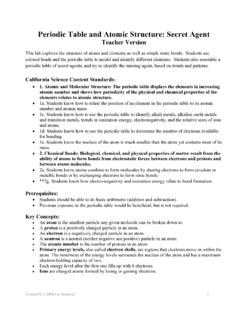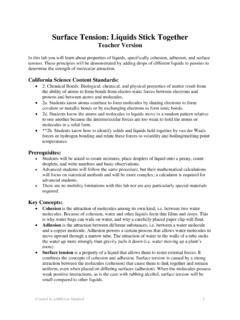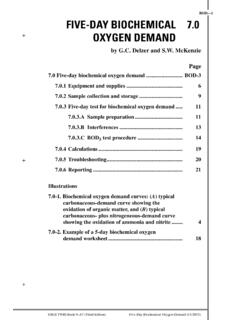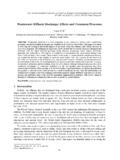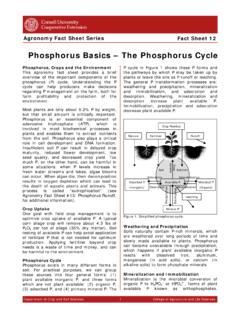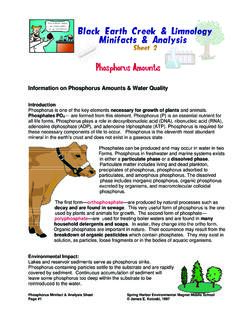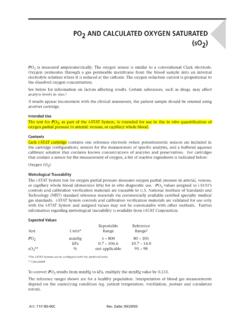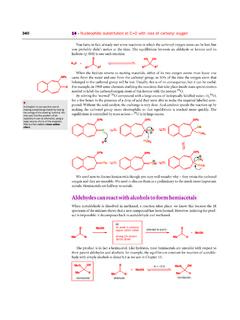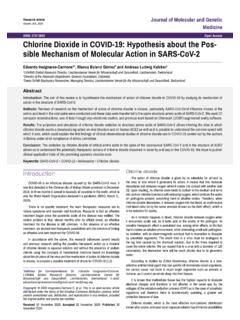Transcription of Photosynthesis: How do plants get energy?
1 Created by LABScI at Stanford 1 Photosynthesis: How do plants get energy? Teacher Version In this lab, students explore the process of photosynthesis in spinach leaves. As oxygen is produced, the density of the leaves change and they will begin floating in a sodium bicarbonate solution. The time it takes for a certain number of leaves to float can be used to calculate the rate of photosynthesis. California Science Content Standards: 1. Cell Biology: The fundamental life processes of plants and animals depend on a variety of chemical reactions that occur in specialized areas of the organism s cells. 1f. Students know usable energy is captured from sunlight by chloroplasts and is stored through the synthesis of sugar from carbon dioxide.
2 Preparation and Lab Notes: 1. Trace two circles on the underside of one shoe box, about 3 inches in diameter. Position the circles at opposite ends. Do the same for the second shoebox, but only trace one hole on one end. 2. Cut out the circles. Label the holes 1, 2, and 3. Label the area not cut out on the second shoebox 4. 3. Along the long side edge of each shoebox, cut two flaps about three inches high, spaced just as the holes. Fold the flaps outward. These will allow for observations of the cups within. 4. Lay each shoebox on its short end over a piece of cardstock. Trace and cut out the card. Insert the card as a divider such that the boxes are evenly divided in half.
3 Fix in place with tape. Complete List of Materials: (for one experimental set-up) 1 8 oz. box baking soda 1 L water Teaspoon Graduated beaker (200mL) 5 transparent cups single hole punch 7 fresh spinach leaves Small bottle of dish soap, clear (if available) 1 large desk lamp ( >60 watt bright white, if possible) 2 sheets of cellophane: one green, one red (transparencies colored with markers work) 4 plastic syringes (10 mL) ruler 2 shoe boxes, pre-cut according to pre-lab directions 2 pieces of cardstock or heavy paper, pre-cut according to pre-lab directions 1 L graduated beaker Created by LABScI at Stanford 2 Key Concepts: Photosynthesis is the primary means by which plants get their energy.
4 They derive this energy from a sugar called glucose (C6H12O6). To make glucose, sunlight is captured in pigments like chlorophyll, the substance that gives leaves their green color. The sun s energy is passed through a chain of events that breaks water (H2O) into oxygen (O2) and creates a store of energy-rich molecules. These molecules will enter a continuous cycle of events to build glucose out of carbon dioxide (CO2 ) from the air. Introductory Mini-Lecture: The chain of events that breaks apart water are called the Light Reactions because they only happen when light is shining on the leaf. The cycle of events that builds glucose are called the Dark Reactions because they are going on both day and night and don t require light to be shining.
5 The whole process together can be summarized like this: 6H2O + 6CO2 ----------> C6H12O6+ 6O2 (Six parts water) and (six parts carbon dioxide) result in (one part glucose) and (six parts oxygen) Some of the oxygen is used by the plant, but most of it is released into the atmosphere, to be breathed in by animals. In return, animals breathe out carbon dioxide, which plants use to create more oxygen (and food for the animals). Sunlight Oxygen is released Glucose is formed Carbon Dioxide Water Energy Chlorophyll Photosynthesis Created by LABScI at Stanford 3 Within a plant cell are green chloroplasts, where all the events of photosynthesis take place.
6 Cross-section of a plant cell The central vacuole, shown in the center, stores the product of photosynthesis: sugar (in various forms like starch). This lab focuses on several different factors that affect the net rate of photosynthesis. We will be comparing the rate of photosynthesis in different light intensities -including in the dark- by viewing the number of leaf disks that rise to the surface of a special solution over time. The solution contains two important ingredients: Sodium Bicarbonate (baking soda) a source of carbon dioxide when dissolved in the solution Dish detergent soap that breaks down the water-repellent barrier on the leaf surface so sodium bicarbonate can get inside As the leaf disks absorb the sodium bicarbonate solution, the density of the leaf increases, it becomes heavier, and the leaf sinks.
7 This experiment takes advantage of the fact that when oxygen leaves the Light Reactions chain, it gets trapped in the inner spaces of the leaf So as photosynthesis takes place in the leaf disk, tiny oxygen bubbles will push out the solution from the leaf spaces and make the leaf disks light enough to rise. Since the amount of oxygen Inner leaf space where oxygen builds up Cell Wall Cell Membrane Vacuole Nucleolus Nucleus Nuclear Membrane Chloroplast Created by LABScI at Stanford 4 released into the leaf interior represents the excess oxygen produced after the Light Reactions, the rate that the disks rise is proportional to the net rate of photosynthesis. The time at which half of the original number of disks are floating can be used to compare net rates of photosynthesis.
8 The value has an inverse relationship with the net rate of photosynthesis; as the net rate increases, the time for half of the disks to float decreases. Hypotheses: QS1. Do you think a light green or a dark green leaf has more chlorophyll? QS2. Will photosynthesis work in the dark? QS3. Do you think chlorophyll works better under a certain color of light? Does chlorophyll absorb all the light that hits a leaf? QSA1. What do you think the effects of varying the type of plant leaf we use will be on the net rate of photosynthesis ( which one will have a faster rate, the cabbage or the spinach and why?)? (provide literature values and an explanation at the end) Different plants have different amounts of chlorophyll hence their rates are different.
9 Spinach is clearly much greener than cabbage, which shows which one has a faster rate of photosynthesis (spinach). QSA2. What do you think the effect of light versus dark will be on the net rate of photosynthesis? plants need light so the chlorophyll can convert it into energy, so the process will only take place when light is present. QSA3. How do you think varying the intensity of light ( distance from the light source) affect the net rate of photosynthesis? The farther away the light source is the longer it takes for the process to occur, and vice versa; the closer the light source is, the faster the rate of photosynthesis. Procedure: 1) Label 5 cups and the 5 syringes in the following manner: No BS light , BS + red , BS + green , BS light , and BS dark.
10 2) Mix 4 tsp of baking soda and 4 tsp of detergent with 800 mL of water in the beaker. Label is as BS solution . 3) Mix 1 tsp detergent with 200 mL of water into the cup labeled No BS light . Label this as No BS solution 4) Place the red cellophane over Hole 1. Place the green cellophane over Hole 2. Leave Hole 3 open. Q4. What type of light will enter each region of the boxes? What type do you think is most favorable to plants ? Created by LABScI at Stanford 5 Hole 1 lets in only red light. Hole 2 lets in only green light. Hole 3 lets in a broad spectrum of light of many colors. The dark chamber 4 lets in no light. The broad spectrum of light is most favorable to plants because chlorophyll absorbs light in the red and blue parts of the color spectrum, which no other cup provides.

